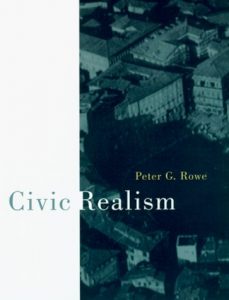Civic Realism
 A civic place belongs to everyone and yet to nobody in particular. In Civic Realism, Peter G. Rowe looks at the shape and appearance of civic places, and at the social, political, and cultural circumstances that bring them into existence. The book is as much about the making and reshaping of civic places as it is about urban architecture per se. According to Rowe, the best civic place-making occurs across the divide between the state and civil society. By contrast, the alternatives are not very attractive. On the one side are state-sponsored edifices and places of authoritarian nature; on the other are the exclusive enclaves of corporate-dominated urban and suburban environments.
A civic place belongs to everyone and yet to nobody in particular. In Civic Realism, Peter G. Rowe looks at the shape and appearance of civic places, and at the social, political, and cultural circumstances that bring them into existence. The book is as much about the making and reshaping of civic places as it is about urban architecture per se. According to Rowe, the best civic place-making occurs across the divide between the state and civil society. By contrast, the alternatives are not very attractive. On the one side are state-sponsored edifices and places of authoritarian nature; on the other are the exclusive enclaves of corporate-dominated urban and suburban environments.
Rowe begins with an example of a civic place that has stood the test of time — Siena’s Piazza del Campo. To be a citizen of Siena is to participate in the life of the Campo. The Campo was and is real, with a realism that encompasses everyday life, occasional events, solemn occasions, and extraordinary celebrations. It is this sense of the word “real” that, together with “civic,” forms the design practice called “civic realism.”
Topics covered in the book include the role of the state and civil society in the constriction of civic spaces, aesthetic and architectural dimensions of realism, individual and collective uses of urban space. And how civic places constitute as well as represent the civic aspect of our lives. The examples, mostly from the modern period, include recent public spaces in Barcelona, several of the Grand Projects in Paris, neorealist projects in postwar Rome, contemporary transformations of the Manhattan grid, and Plecnik’s water axis in prewar Ljubljana.
Contents
- Reexamining the Public Realm
An Organization of Public and Civic Life
Siena’s Piazza del Campo
Underlying Themes of Civic Realism
- Civic Realms and Public Places
The Urban Public Spaces of Barcelona
Civic Interaction between the State and Civil Society
Civic Place Making and the Parisian Grand Projects
- Realism and World Making
Strains of Aesthetic Realism
Neorealism and Rome’s Postwar Development
Definition of Architectural Realism
- Individual Spaces and Collective Places
Transformation of Space into Place
Resistance, Manifestation, and New York’s Grid
Accommodation of a Plurality of Interests
- Representation and Constitution of Spatial Meanings
Regionalism and Plans for a City
Plecnik’s Water Axis in Ljubljana
Constitutive and Representational Aspects of Public Domains
- The Practice of Civic Realism
The Civic, the Real, and the Specific
Civic Realism as a Constellation of Conceptual Dimensions
Toward a Well-Grounded Contemporaneity
MIT Press, 1997